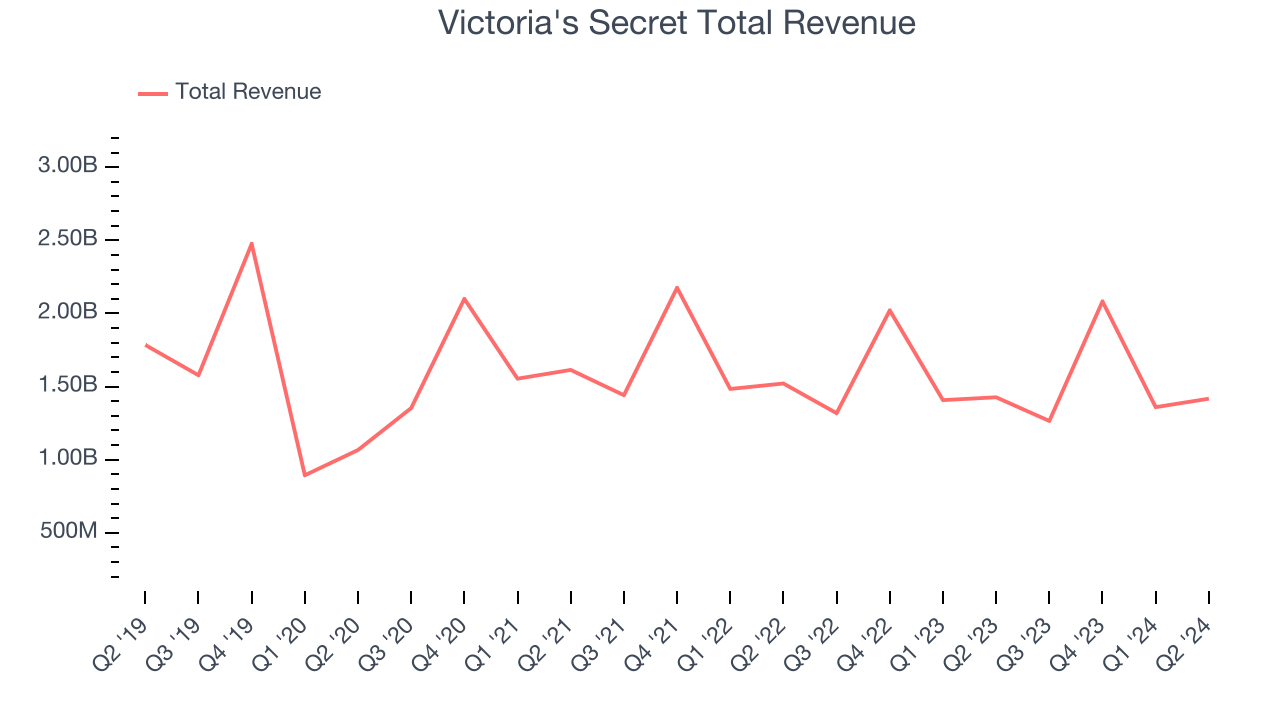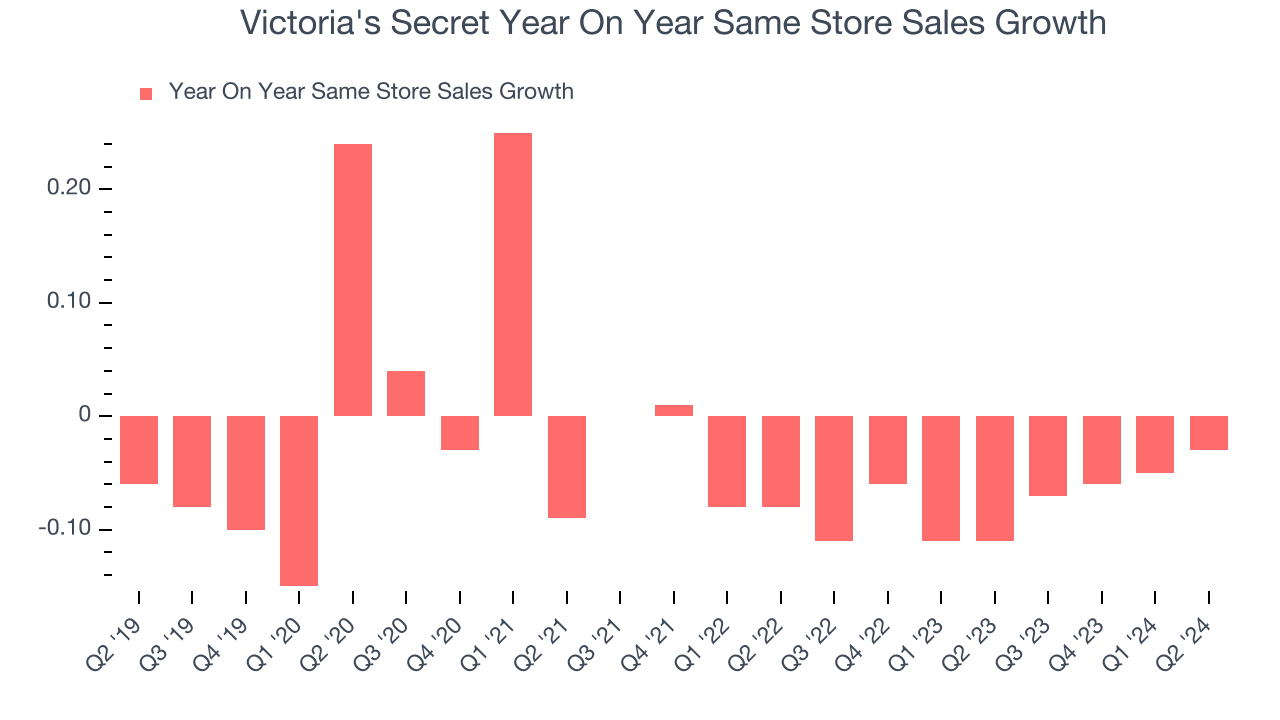Intimatewear and beauty retailer Victoria’s Secret (NYSE:VSCO) reported results in line with analysts’ expectations in Q2 CY2024, with revenue flat year on year at $1.42 billion. The company expects next quarter’s revenue to be around $1.27 billion, coming in 1.2% above analysts’ estimates. It made a non-GAAP profit of $0.40 per share, improving from its profit of $0.24 per share in the same quarter last year.
Is now the time to buy Victoria's Secret? Find out in our full research report.
Victoria's Secret (VSCO) Q2 CY2024 Highlights:
- Revenue: $1.42 billion vs analyst estimates of $1.41 billion (small beat)
- EPS (non-GAAP): $0.40 vs analyst estimates of $0.38 (4.7% beat)
- Revenue Guidance for Q3 CY2024 is $1.27 billion at the midpoint, above analyst estimates of $1.25 billion
- EPS (non-GAAP) guidance for Q3 CY2024 is -$0.70 at the midpoint, below analyst estimates of -$0.68
- Gross Margin (GAAP): 35.4%, in line with the same quarter last year
- Locations: 1,373 at quarter end, up from 1,350 in the same quarter last year
- Same-Store Sales fell 3% year on year (-11% in the same quarter last year)
- Market Capitalization: $1.94 billion
Interim Chief Executive Officer and Chief Financial and Administrative Officer Timothy (TJ) Johnson commented, “Our financial results for the second quarter came in at the high end of expectations and we delivered year-over-year quarterly operating income growth for the first time since 2021. We were encouraged by the continued sequential improvement in quarterly sales results in North America for the fourth consecutive quarter, as sales trends improved in both our stores and digital channels. Our customers responded to new merchandise deliveries and events with particular success in the launch of our Victoria’s Secret Dream bra collection, in apparel with our PINK Friday back to campus event in late July and consistent, steady improvement of VS sport as merchandise flowed to stores and digital. Improving product acceptance and disciplined inventory management led to gross margin dollar growth and rate expansion, and our teams continue to be relentlessly focused on improving our cost structure, driving a decrease in SG&A dollars and leverage year-over-year. In addition to improving trends for Victoria’s Secret and PINK, we experienced sales growth in the high-single digits for both our International business and Adore Me.”
Spun off from L Brands in 2020, Victoria’s Secret (NYSE:VSCO) is an intimate clothing and beauty retailer that sells its own brands of lingerie, undergarments, and personal fragrances.
Apparel Retailer
Apparel sales are not driven so much by personal needs but by seasons, trends, and innovation, and over the last few decades, the category has shifted meaningfully online. Retailers that once only had brick-and-mortar stores are responding with omnichannel presences. The online shopping experience continues to improve and retail foot traffic in places like shopping malls continues to stall, so the evolution of clothing sellers marches on.
Sales Growth
Victoria's Secret is larger than most consumer retail companies and benefits from economies of scale, giving it an edge over its competitors.
As you can see below, the company’s revenue has declined over the last four years, dropping 4.3% annually as it failed to grow its store footprint meaningfully and observed lower sales at existing, established stores.

This quarter, Victoria's Secret reported a rather uninspiring 0.7% year-on-year revenue decline to $1.42 billion in revenue, in line with Wall Street’s estimates. The company is guiding for a 0% year-on-year revenue decline next quarter to $1.27 billion, an improvement from the 4% year-on-year decrease it recorded in the same quarter last year. Looking ahead, Wall Street expects revenue to remain flat over the next 12 months, a deceleration from this quarter.
Unless you’ve been living under a rock, it should be obvious by now that generative AI is going to have a huge impact on how large corporations do business. While Nvidia and AMD are trading close to all-time highs, we prefer a lesser-known (but still profitable) semiconductor stock benefitting from the rise of AI. Click here to access our free report on our favorite semiconductor growth story.
Same-Store Sales
A company’s same-store sales growth shows the year-on-year change in sales for its brick-and-mortar stores that have been open for at least a year, give or take, and e-commerce platform. This is a key performance indicator for retailers because it measures organic growth and demand.
Victoria's Secret’s demand has been shrinking over the last eight quarters, and on average, its same-store sales have declined by 7.5% year on year. This performance is quite concerning and the company should reconsider its strategy before investing its precious capital into new store buildouts.

In the latest quarter, Victoria's Secret’s same-store sales fell 3% year on year. This decrease was an improvement from the 11% year-on-year decline it posted 12 months ago. It’s always great to see a business improve its prospects.
Key Takeaways from Victoria's Secret’s Q2 Results
It was encouraging to see Victoria's Secret slightly beat analysts’ revenue guidance expectations. We were also happy its revenue narrowly outperformed Wall Street’s estimates in the reported quarter. On the other hand, its earnings forecast for next quarter missed analysts’ expectations and its gross margin missed Wall Street’s estimates. Overall, this quarter was mixed but likely better than feared given how cautious some consumer discretionary and apparel companies sounded as they spoke about the macro environment. The stock traded up 3.1% to $25.65 immediately after reporting.
So should you invest in Victoria's Secret right now? When making that decision, it’s important to consider its valuation, business qualities, as well as what has happened in the latest quarter. We cover that in our actionable full research report which you can read here, it’s free.
